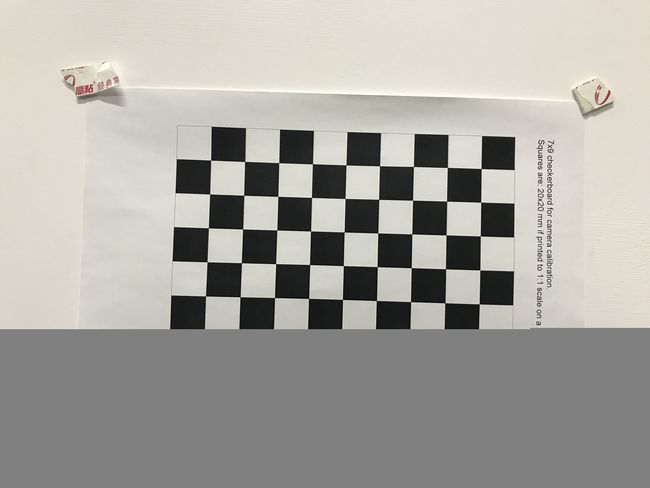ORB-SLAM2运行自己的数据集(单目)
文章目录
- 环境
- 数据获取
- 相机标定
- 数据预处理
环境
· ubuntu 18.04
· ORB-SLAM2
假设环境已经配好且ORB-SLAM2已经编译完成
数据获取
可以用手机或者其他设备采集数据,我用的是Sony Xperia Z5采集的视频,视频分辨率为1920*1080,fps为59.87
相机标定
本例采用7x9的棋盘格进行相机标定,如图1所示
步骤:
import numpy as np
import cv2
import glob
import os
'''
相机标定脚本
'''
# termination criteria
criteria = (cv2.TERM_CRITERIA_EPS + cv2.TERM_CRITERIA_MAX_ITER, 10, 0.001)
row_no = 9
col_no = 7
#这里用的图7行*9列
# prepare object points, like (0,0,0), (1,0,0), (2,0,0) ....,(6,5,0)
objp = np.zeros((row_no*col_no,3), np.float32)
objp[:,:2] = np.mgrid[0:row_no,0:col_no].T.reshape(-1,2)
# Arrays to store object points and image points from all the images.
objpoints = [] # 3d point in real world space
imgpoints = [] # 2d points in image plane.
images = os.listdir('./img/')
for fname in images:
img = cv2.imread('./img/'+fname)
gray = cv2.cvtColor(img,cv2.COLOR_BGR2GRAY)
# Find the chess board corners
ret, corners = cv2.findChessboardCorners(gray, (row_no,col_no),None)
# If found, add object points, image points (after refining them)
if ret == True:
objpoints.append(objp)
corners2 = cv2.cornerSubPix(gray,corners,(11,11),(-1,-1),criteria)
imgpoints.append(corners2)
# Draw and display the corners
img = cv2.drawChessboardCorners(img, (row_no,col_no), corners2,ret)
cv2.imshow('img',img)
cv2.waitKey(30)
cv2.destroyAllWindows()
ret, mtx, dist, rvecs, tvecs = cv2.calibrateCamera(objpoints, imgpoints, gray.shape[::-1],None,None)
print(mtx)
print(dist)
np.savetxt('./matrix.txt',mtx)
np.savetxt('./dist.txt',dist)
h, w = img.shape[:2]
newcameramtx, roi=cv2.getOptimalNewCameraMatrix(mtx,dist,(w,h),1,(w,h))
for fname in images:
img = cv2.imread('./img/'+fname)
# 通过调用函数,传递ROI参数就可以复制结果。
dst = cv2.undistort(img, mtx, dist, None, newcameramtx)
# crop the image
x, y, w, h = roi
dst = dst[y:y + h, x:x + w]
cv2.imshow('img', img)
cv2.imshow('dst', dst)
cv2.waitKey(0)
# 首先找到原图片与校正图片之间映射函数。然后使用重映射函数。
# undistort
# mapx, mapy = cv2.initUndistortRectifyMap(mtx, dist, None, newcameramtx, (w, h), 5)
# dst = cv2.remap(img, mapx, mapy, cv2.INTER_LINEAR)
#
# # crop the image
# x, y, w, h = roi
# dst = dst[y:y + h, x:x + w]
# cv2.imwrite('calibresult.png', dst)
标定结果如下:
相机内参矩阵
1.480823466461038151e+03 0.000000000000000000e+00 9.428762100578752552e+02 0.000000000000000000e+00 1.495030449101173872e+03 5.331657639570393030e+02 0.000000000000000000e+00 0.000000000000000000e+00 1.000000000000000000e+00
畸变系数
-5.551663673857653442e-02 9.888473859774349339e-02 -1.988202569460489292e-03 -1.191351830829561788e-02 -2.278315633704405818e-01
然后再到ORB_SLAM2/Examples/Monocular目录下复制KITTI00-02.yaml,重命名为z5.yaml,并打开,然后将上述标定的参数写入z5.yaml对应位置。
数据预处理
用z5拍摄一段视频,然后用一下脚本进行数据预处理
# coding:utf-8
import os
import cv2
import numpy as np
from multiprocessing import Pool
class Kitti():
def __init__(self, video_parent_dir, frame_interval, img_width, img_height):
'''
:param video_father_dir: video father dir file dir
:param frame_interval: every frame_interval save a key frame
:param img_width: img sequence width
:param img_height: img sequence height
'''
self.video_dirs = [video_parent_dir+dir for dir in os.listdir(video_parent_dir)]
self.frame_interval = frame_interval
self.img_width = img_width
self.img_height = img_height
self.dir_cnt = 0
def get_format_name(self, idx, lenght):
'''
:param idx: given img index, such as 1, 2, 3
:lenght: format name length
:return: return format img name like 000001, 000002, ...
'''
cnt = lenght - 1
prefix = ''
nmb = idx
while idx // 10 != 0:
cnt -= 1
idx = idx // 10
for i in range(cnt):
prefix += '0'
return prefix + str(nmb)
def run(self,video_dir):
videoCapture = cv2.VideoCapture(video_dir)
# get video fps
fps = videoCapture.get(cv2.CAP_PROP_FPS)
# get vide width and height
size = (int(videoCapture.get(cv2.CAP_PROP_FRAME_WIDTH)), int(videoCapture.get(cv2.CAP_PROP_FRAME_HEIGHT)))
width_offset = int((size[0] - self.img_width) / 2)
height_offset = int((size[1] - self.img_height) / 2)
print('=======================')
print('init_size: ',size)
print('dest_size: (',self.img_width,',',self.img_height,')')
img_sequence_parentdir = './' + self.get_format_name(self.dir_cnt, 2)
if not os.path.exists(img_sequence_parentdir):
os.makedirs(img_sequence_parentdir)
if not os.path.exists(img_sequence_parentdir + '/image_0/'):
os.makedirs(img_sequence_parentdir + '/image_0/')
# 读帧
success, frame = videoCapture.read()
total_frame_idx = 0 # video frame index
count = 0 # keyframe number
tmp_cnt = 0 # record new cycle frame number
timestep = 0 # time step
timestep_total = [0] # save every time step
print("Fps: ", fps)
print('=======================')
while success:
# 每秒采2帧
if tmp_cnt == 0 or tmp_cnt == self.frame_interval:
format_img_name = img_sequence_parentdir + '/image_0/' + self.get_format_name(count, 6) + '.png'
print(format_img_name)
cv2.imwrite(format_img_name,
frame[height_offset:height_offset + self.img_height,
width_offset:width_offset + self.img_width])
count += 1
tmp_cnt = 0
timestep += self.frame_interval / fps
timestep_total.append(timestep)
success, frame = videoCapture.read() # 获取下一帧
total_frame_idx = total_frame_idx + 1
tmp_cnt += 1
self.dir_cnt += 1
np.savetxt(img_sequence_parentdir + '/times.txt', timestep_total)
def main(self):
# pool = Pool()
# pool.map(self.run,self.video_dirs)
# pool.close()
# pool.join()
for video_dir in self.video_dirs:
self.run(video_dir)
if __name__ == "__main__":
K = Kitti('./video/',2,1920,1080)
K.main()
上述脚本运行完成后,会得到如下的文件:
00|
image_0
times.txt
image_0 保存的是关键帧序列, times.txt保存的是关键帧对应的时间
注:这里所指的关键帧是指我们在视频中每隔frame_interval 采样的帧。如,视频总长度为10帧,设置每隔1帧采样一帧,那么关键帧为第1,3,5,7,9 (index从零开始)。frame_interval 为Kitti类的第二个参数,可以自己调整。
class Kitti():
def __init__(self, video_parent_dir, frame_interval, img_width, img_height):
使用自己拍摄的数据运行ORB-SLAM2,如下:
-
进入ORB_SLAM2目录
-
./Examples/Monocular/mono_kitti ./Vocabulary/ORBvoc.txt PATH_TO_z5.yaml ./PATH_TO_IMAGE_SEQUENCE
(本机命令如下:./Examples/Monocular/mono_kitti ./Vocabulary/ORBvoc.txt ./Examples/z5.yaml /media/lab/ff048a6a-f7ae-4301-9843-39db29f48c47/lib/Downloads/img_sequence2/01)
最终结果:
